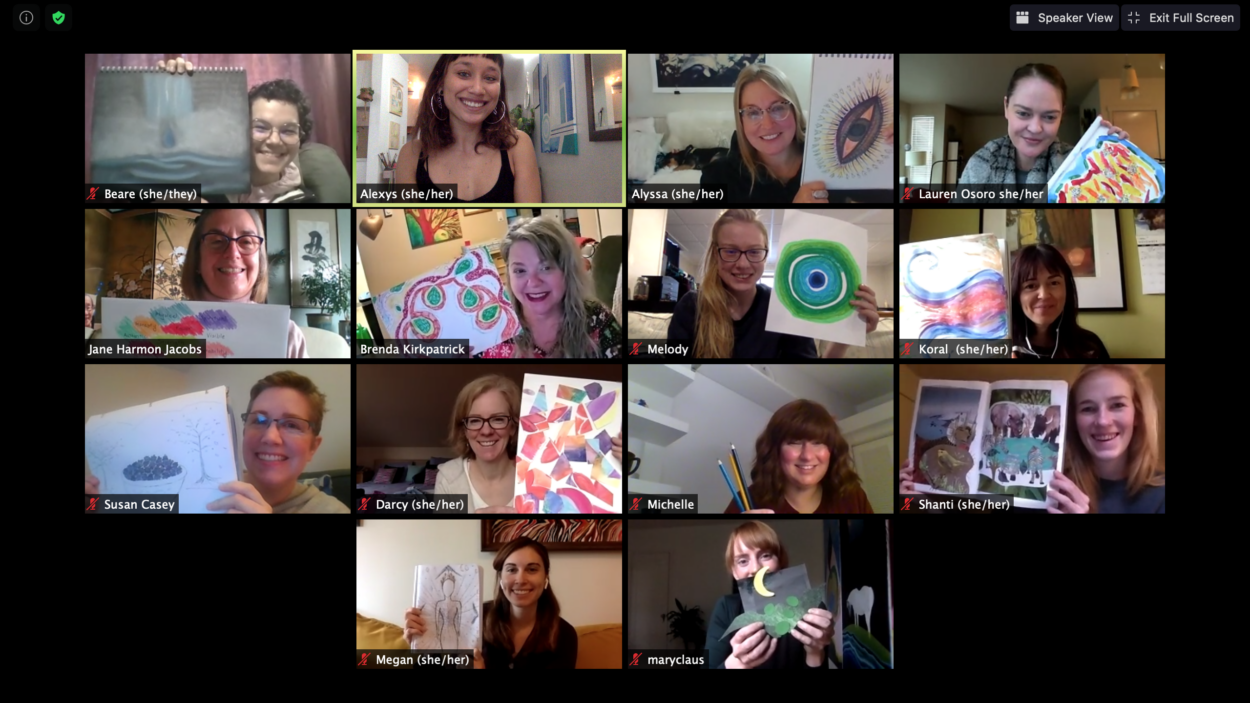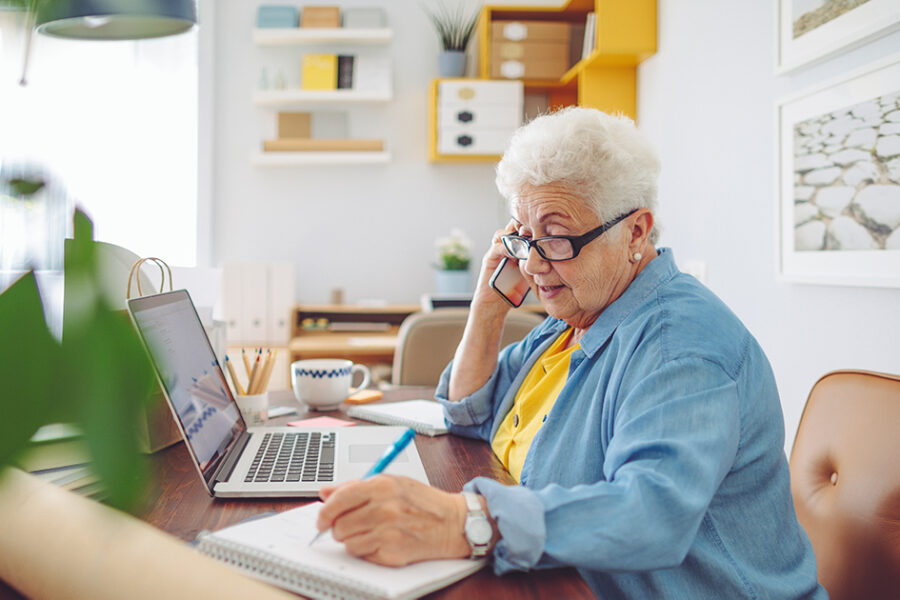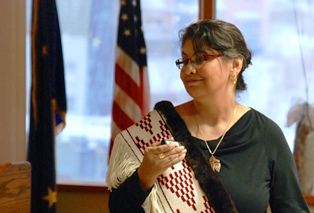When the Women’s Education Program opened at Antioch University Seattle twenty-two years ago, its mission was simple: to provide a weekly hot breakfast and space of support—and art materials—for women experiencing homelessness. Over the following decades, the organizers maintained this model, while also remaining flexible. Now, in the midst of an ongoing global pandemic, the Women’s Education Program (WEP) is having to be more flexible than ever. Through the committed work of student volunteers, faculty, and staff, the program has adapted to a Zoom-powered online format. These days no hot breakfast is served, but women are still gathering, now from across the globe, and finding in WEP a space of supportive community and exploratory art-making.
“That’s our hope right now: that we can evolve with the current reality and still be a place for creative community and sharing,” says Alyssa Griskiewicz. Griskiewicz, as faculty in Antioch’s Art Therapy program, has together with Antioch University Seattle (AUS) Special Assistant for Academic Affairs Jane Harmon Jacobs taken on much of the administration of the program. She sees WEP, both when it was held in-person and now over Zoom as a place where “womxn from many different spectrums of identity, age, and experience can come together to share, create, reflect and be just who they are in creative community.”
For now, WEP meets from 10-11am PST on a drop-in basis. Those who might be interested in participating can get more information and join the group by emailing [email protected].
A Diversity of Participants From the Start
WEP opened at AUS’s 6th Street campus in 1998. It was a collaboration with an organization of women experiencing homelessness, called the Women’s Housing, Equity, and Enhancement League (WHEEL) and with the Sister’s Project, a day program for unhoused women. Antioch staff, faculty, and students from across the university helped organize and run the program. Different departments and programs would buy, prepare, and serve the breakfast each week. Mary Lou Finley, who founded and for many years led the program, remembers an especially memorable morning “when the education staff brought their electric skillets to make bacon and pancakes.” As she describes it, “they succeeded in blowing the fuses for the building and making the entire building smell like bacon frying!”
WEP had to remain flexible over the years, and an early change was to expand its clientele to include not just women currently experiencing homelessness but also women who have transitioned back into having secure housing. The period when women are transitioning out of the shelter system, explains Finley, “is often an especially isolating time.” The continuity of this community and these services can be a valuable bridge and resource.
Some women have been attending the program for decades—a few even since its very founding. “Obviously, their situations have changed over the years, from experiencing homelessness to now living in homes and apartments,” says Griskiewicz, but they still find WEP to be an integral place where they can “stay in community and have a reliable and regular time to make new friends and stay connected with folks they have built relationships with over the years.”
The group attending WEP fluctuates from week to week—especially now that it’s online—but it has always been diverse in many ways, from age and background to ethnicity and racial identity. The program is also explicitly open and inclusive of transwomen and non-binary folks. Says Griskiewicz, anyone who identifies with their own feminine energy is welcome to be a part of this community. It was always intended to be an inclusive community.
From Student Volunteer to Program Supervisor
Griskiewicz’s involvement with WEP began when she was a student at AUS and began volunteering in the program. She was immediately taken by the way that “it really walked Antioch’s talk, the talk of being engaged in the local community and staying true to its roots in social justice.” After breakfast and the morning check-in in a classroom space, some participants would stay there to work on a writing project or check out a university computer to take care of logistical pieces of their lives. Others would move into the arts studio to work on various creative projects. As an art therapy student, Griskiewicz usually spent time in the art studio with them.
“They women were given access to loads of art materials, but many of them didn’t really know how to use them,” she explains. “I saw an opportunity to step in as an artist to simply share what I knew, and especially about clay and ceramics.” She helped them learn to make more functional bowls and showed them more advanced ceramic techniques.
Later in her studies, she realized that she wanted to use WEP as a secondary setting for her clinical internship. Here she was able to put her training in art therapy into practice while supporting these women through their own creative process.
Griskiewicz moved away from Seattle when she graduated in 2013, but when she returned as faculty in 2016 she once again became involved in WEP. “I’ve feel really lucky to be back in community with some of the womxn who were utilizing the program when I was a student, and are still coming back today,” she says.
At its founding WEP was largely led by Finley, who served as core faculty in the BA Completion Program. (She is now an emeritus faculty member.) Today, Griskiewicz supervises the program, and she has brought to it a broader engagement with the Art Therapy program. WEP now serves a secondary duty of helping pre-internship practicum students to get valuable experience and training as they create a supportive and creative space for the women who participate. The practicum program has served more than 10 student interns since it began last year and continues to grow in it’s online format.
The practicum program is in some ways a continuation of Griskiewicz’s work as a student in the program—a way to combine the volunteer service that sustains WEP with academic study, creativity and progress.
The Shift to Zoom
This productive mixture of food, community, and art therapy was all thrown into peril in early March, 2020, when the government in Seattle instituted a shelter-in-place order to slow the spread of COVID-19. Abruptly the program had to be shut down, together with the rest of the AUS campus. As the weeks dragged on, it became clear that a quick reopening was not going to happen. And at the same time, the need in the community they served was greater than ever.
That was when the WEP organizers decided to reimagine the program in an online format, at least for the duration of the pandemic. Obviously, they wouldn’t be able to provide hot breakfast, but they might be able to offer the rest of what makes WEP special. The team of students, faculty, and staff got to work.
These days, WEP meets on Zoom every Thursday morning, from 10-11am Pacific Time. Meetings start with a check-in and introductions. At this time, says Griskiewicz, there’s usually “a creative question for folks to ponder and check in about…maybe noticing a color that’s really speaking to them in the space, or an element of nature that they’d like to share.”
After this, the students leading each session offer an art therapy directive. Participants use whatever materials they have to hand. Some have extensive watercolors; others use ballpoint pens on printer paper. There might be a grounding meditation or an invitation to reflect on a particular theme.
At the end, explains Griskiewicz, the organizers leave a little time for folks to share “what their experience was, what they created, what they thought about or were inspired by.” It can be an emotional time, and it’s always a time for people to share, reflect, and connect.
Of course there are drawbacks to moving WEP to Zoom, foremost being that many women experiencing homelessness do not have reliable access to the internet. There are also the challenges of Zoom fatigue and limited modes of communication. Nonetheless, the program in its current form is clearly a strong answer to a tough situation.
And the Zoom format is enabling at least one feature that would have been impossible during in-person WEP: women are able to join from anywhere that has an internet connection. Join they have, from all over the world. Many have found out about the program through extended Antioch networks. And Griskiewicz says, “We still do have a few participants every month who check in from our prior community.”
Safety, Community, Art
One of the students currently helping facilitate WEP is Maryssa Beare, a student in Couple and Family Therapy with a specialization in Art Therapy. She is a co-facilitator for Fall 2020 and Winter 2021 quarters, working with fellow WEP facilitators to plan and run WEP sessions.
She sees WEP as meeting a series of concentric needs. “First and foremost, WEP has always been about providing, at its most bare minimum, a space for womxn to just safely exist,” she says. “Then it progresses from there as a space for womxn to be with community. Then a community space for womxn to make art. Community and art are both healing, so to have them together makes perfect sense!”
Beare chose to become part of WEP because she was struck by its origins—but also because she was curious how that could translate during a pandemic. “I wanted to see how it was being accomplished,” she says. And what she’s seen—and participated in—has been inspiring. She says,“Alyssa and Jane haven’t stopped serving our original population, finding ways to better and more fully serve, and brainstorming ways to develop inclusive spaces with the same heart as WEP.”
WEP is meeting a present and urgent need with creativity and passion. And all of this means that, once the pandemic restrictions are lifted, the program will be well-positioned to thrive for decades to come. Says Griskiewicz, “We’re hoping that we can keep the program vital for now, with an intention to come back together in person, to share cups of hot tea and coffee together, and to get our hands back into the clay.”



